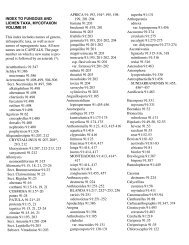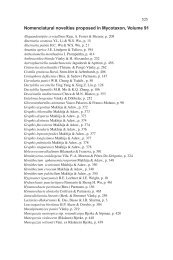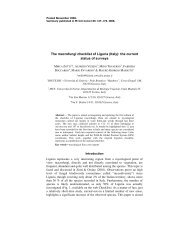download full review [pdf] - Mycotaxon
download full review [pdf] - Mycotaxon
download full review [pdf] - Mycotaxon
Create successful ePaper yourself
Turn your PDF publications into a flip-book with our unique Google optimized e-Paper software.
552 ... Hawksworth, Editor<br />
but as pointed out by Per Magnus in the Preface, covering the lichens with<br />
cyanobacterial partners proved more difficult than at first perceived as many<br />
small genera had not been critically assessed in the region. Twelve families<br />
are covered, Arctomiaceae (2 genera), Coccocarpiaceae (1), Collemataceae<br />
(4), Heppiaceae (2), Lichinaceae (21), Lobariaceae (3), Massalongiaceae (3),<br />
Nephromataceae (1), Pannariaceae (9), Peltigeraceae (2), Peltulaceae (1), and<br />
Placynthiaceae (3). All accounts are authored by Per Magnus, apart from<br />
Nephromataceae and Peltigeraceae, which were prepared by Orvo Vitikainen. In<br />
cases where a genus also includes species that have only a green photosynthetic<br />
partner, these are also treated.<br />
As only would be expected from these authors, the accounts are meticulously<br />
prepared, and largely follow the format of the earlier volumes. Maps for 217<br />
species are included, along with 232 superb habit or detailed photographs in<br />
colour; an index to the collection details of the specimens photographed is<br />
provided. The CD contains the same photographs with separate files in two<br />
series, generic (with a file for each genus) and specific (a single alphabetical<br />
list). Of especial value amongst these are those of the undersides of Peltigera<br />
species, where the nature of the veins and rhizines are not always easy to grasp<br />
from the written word or sketches; I am sure those pages will soon become well<br />
thumbed!<br />
Noting that there was a six-page appendix entitled “Nomenclatural<br />
novelties”, I went to that with some trepidation at the name changes that<br />
might be introduced. But what a relief when I found there were just three<br />
new combinations, Epiphloea byssina (syn. Collema byssinum), Pterygiopsis<br />
concordatula (syn. Pyrenopsis concordatula), and Thallinocarpon nigritellum<br />
(syn. Thyrea nigritella), and 39 lecto-, neo- or epitypifications. Many of the<br />
epitypifications relate to names of common species based on illustrations in the<br />
1742 Historia muscorum of Dillenius, and are welcome in now tying these<br />
names to specimens rather than figures. There is an index to synonyms, but<br />
surprisingly not to accepted species where I would have found one to epithets<br />
most helpful in view of the changing dispositions of some of the smaller species<br />
covered. Some other changes are found in the text, including the resurrection<br />
of the long-unused Massalongian generic name Collolechia dating from 1854<br />
for the species previously referred to as Placynthium caesium; it differs from<br />
Placynthium in both thallus anatomy (crustose not squamulose) and apothecial<br />
characters (asci with an amyloid ring not a cap or sheath). I was also pleased to<br />
see the placement of Thyrea nigritella resolved (see above) as it has also featured<br />
in Gonohymenia and Lichinella in recent times.<br />
While focused on the Nordic countries, as so many of the species are known<br />
elsewhere in Europe or are circumboreal, this is a work lichenologists in general<br />
should endeavour to acquire. It is to be hoped that further volumes in the series


![download full review [pdf] - Mycotaxon](https://img.yumpu.com/5381692/44/500x640/download-full-review-pdf-mycotaxon.jpg)




